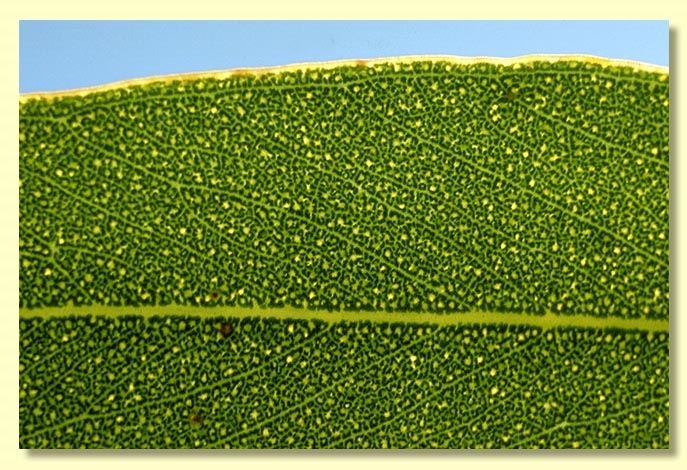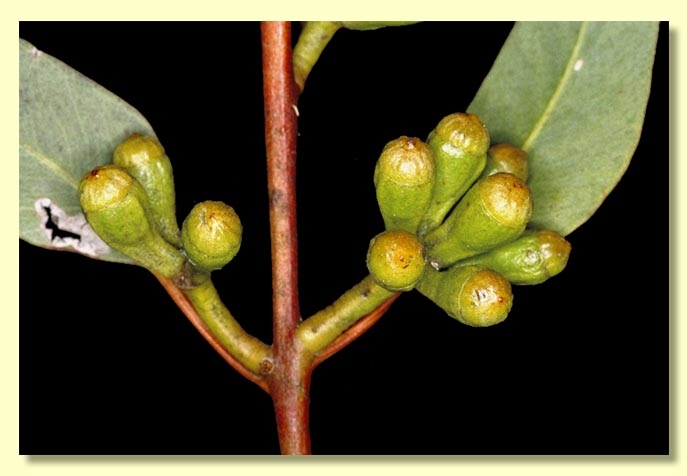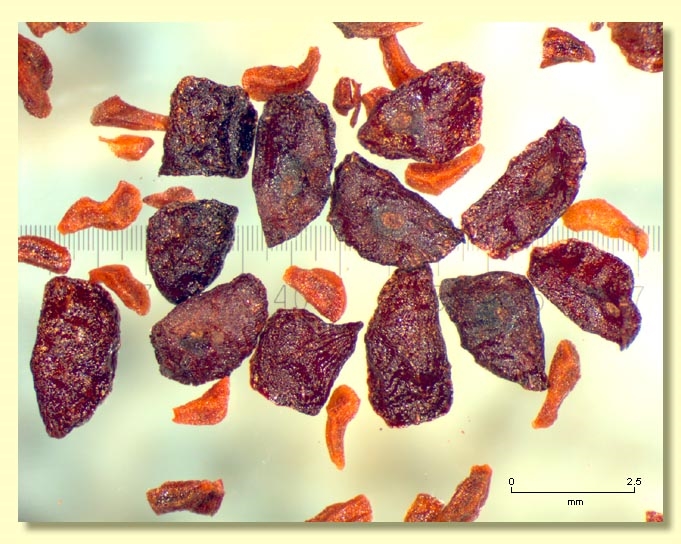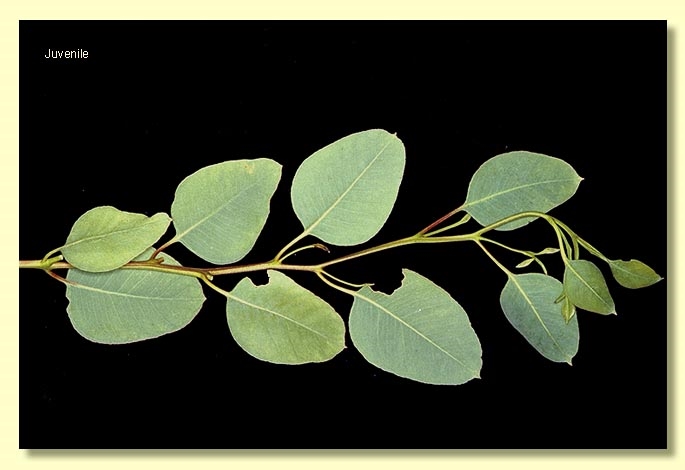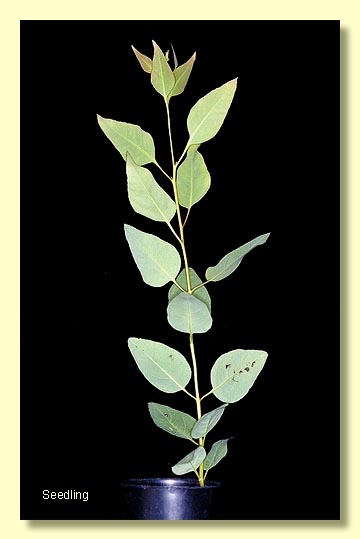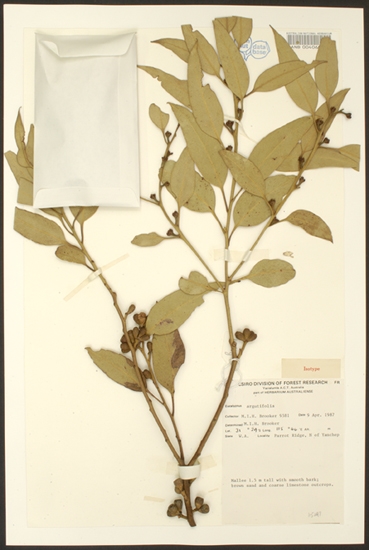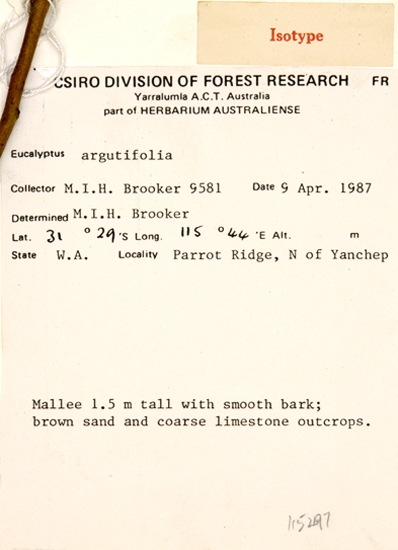Euclid - Online edition
Eucalyptus argutifolia
Eucalyptus | Symphyomyrtus | Dumaria | Rufispermae
Mallee to 4 m tall. Forming a lignotuber.
Bark smooth throughout, grey to pale coppery.
Branchlets with pith glands restricted to nodes.
Juvenile growth (coppice or field seedlings to 50 cm): stems rounded to square in cross-section, smooth; juvenile leaves always petiolate, opposite for very few nodes then alternate, orbicular to ovate or deltoid, 4–7 cm long, 3–5.5 cm wide, base rounded to tapering, apex rounded to broadly pointed, green, glossy.
Adult leaves alternate, petioles 1.8–2.5 cm long; blade broadly lanceolate to lanceolate, 7.3–12 cm long, 1.2–3 cm wide, (Most herbarium specimens, and therefore plants, appear to have intermediate leaves with fully adult leaves being to 12 cm long and < 2cm wide.), base tapering to petiole, margin entire, apex pointed, concolorous, glossy, green, side-veins at an acute or wider angle to midrib, reticulation very dense, intramarginal vein present, oil glands mostly intersectional.
Inflorescence axillary unbranched, peduncles stout, 0.5–1.5 cm long, buds 7 or 9 (rarely 11) per umbel, almost sessile or pedicellate, pedicels 0.1–0.5 cm long. Mature buds ovoid to obovoid (0.7–1.1 cm long, 0.4–0.6 cm wide), scar present, operculum rounded and as wide as hypanthium (0.3–0.4 cm long), stamens inflexed, anthers cuboid to wedge-shaped, versatile, dorsifixed, dehiscing by longitudinal slits, style long and straight, stigma more or less rounded, locules 4 or 5, the placentae each with 4 vertical rows of ovules. Flowers white.
Fruit sessile or pedicellate (pedicels 0–0.3 cm long), cylindrical to cupular-obconical, 0.6–1.1 cm long, 0.7–0.8 cm wide, slightly ribbed or not, disc descending, valves 4 or 5, to rim level.
Seeds reddish brown and glossy, 1.5–3.2 mm long, flattened-ovoid and somewhat angular in outline, dorsal surface often lacunose, shallowly reticulate, hilum ventral.
Cultivated seedlings (measured at ca node 10): cotyledons reniform; stems square in cross-section; leaves always petiolate, opposite for 4 to 7 nodes then alternate, ovate, 3.5–8 cm long, 3–4.5 cm wide, dull, green.
Flowering has been recorded in January.
A mallee endemic to Western Australia and known from north of Yanchep, a northern suburb of Perth, on Wabling Hill, Parrot Ridge and also south of the coastal town of Seabird; of near-coastal distribution on limestone. The bark is smooth and the adult leaves are glossy green.
In the classification of Brooker (2000) Eucalyptus argutifolia belongs in Eucalyptus subgenus Symphyomyrtus section Dumaria having these features: buds initially with two opercula the outer shed early, stamens strongly inflexed, ovules in 4 rows on the placentae and cotyledons reniform. Within section Dumaria the species belongs to a large sub-group of closely related species (series Rufispermae, 37 described species and subspecies) diagnosed by glandular pith in the branchlets, anthers cuboid to wedge-shaped and versatile, and by the reddish brown and glossy, flattish seeds which are unique to the series.
E. argutifolia is probably most closely related to the widespread E. phenax subsp. phenax, from which it differs by the broader juvenile leaves, broader glossier adult leaves and buds with rounded (not conical) opercula. No other closely related species (i.e. in series Rufispermae) occurs in this coastal area; however, the variably glaucous mallee or small tree, E. obtusiflora, occurs in coastal and subcoastal areas to the north extending inland to the Wongan Hills.
Eucalyptus argutifolia is listed as "Vulnerable" under the Australian Government Environment Protection and Biodiversity Conservation Act 1999 (EPBC Act). Further information may be found at this web address:
http://www.environment.gov.au/cgi-bin/sprat/public/sprat.pl



